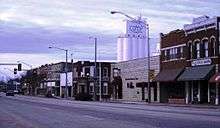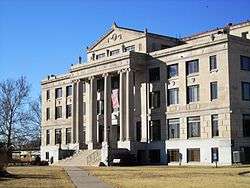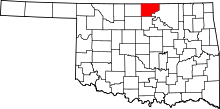Newkirk, Oklahoma
| Newkirk, Oklahoma | |
|---|---|
| City | |
|
Kay County Courthouse (2010) | |
|
Location of Newkirk within Oklahoma | |
| Coordinates: 36°52′59″N 97°3′21″W / 36.88306°N 97.05583°WCoordinates: 36°52′59″N 97°3′21″W / 36.88306°N 97.05583°W | |
| Country | United States |
| State | Oklahoma |
| County | Kay |
| Government | |
| • Type | Council-manager |
| Area | |
| • Total | 1.3 sq mi (3.4 km2) |
| • Land | 1.3 sq mi (3.4 km2) |
| • Water | 0.0 sq mi (0.0 km2) |
| Elevation | 1,152 ft (351 m) |
| Population (2010) | |
| • Total | 2,317 |
| • Density | 1,800/sq mi (680/km2) |
| Time zone | Central (CST) (UTC-6) |
| • Summer (DST) | CDT (UTC-5) |
| ZIP code | 74647 |
| Area code(s) | 580 |
| FIPS code | 40-51300 [1] |
| GNIS feature ID | 1095856 [2] |
| Website | Newkirk CoC |
Newkirk is a city and county seat of Kay County, Oklahoma, United States.[3] The population was 2,317 at the 2010 census.
History

Newkirk is located on land known as the Cherokee Strip which belonged to the Cherokee Indians. In 1893, the Cherokee sold the land, then part of Oklahoma Territory to the United States government. The land was opened to White settlement by means of the Cherokee Strip Land Run on September 16, 1893. More than 100,000 people raced to claim plots of land.
The town of Newkirk had been laid out before the run by the government as the county seat of “K” county. It was named Lamoreaux after Silas W. Lamoreaux, who was commissioner of the General Land Office.[4] Two miles north of Lamoreaux was Kirk, a Santa Fe Railroad cattle-shipping station.[5]
That first day of the land run, 5,000 people staked claims in and near Lamoreaux. Claimants were allowed two town lots: one for a home and one for a business. In designated rural areas, claimants could select 160 acres. The population quickly dropped to about 2,100 as disappointed land seekers left. A town government was organized and among the first items of business was to change the name of the town from Lamoreaux to Santa Fe. The railroad, however, did not approve the name as several other places were named Santa Fe. Meanwhile, the railroad station at Kirk had been closed, so the name Newkirk was chosen on November 8, 1893.[6]
In 1901, Newkirk suffered a major reversal when nearly a whole block of its thriving downtown burned. The wood buildings that burned were mostly replaced with stone buildings from the distinctive yellow limestone quarried four miles east of Newkirk. “Imposing stone buildings began to give dignity and permanence to the dusty streets, while wood-frame homes gradually replaced the “proving-up” homes of the Run. Young Elms, Cottonwoods, shrubs, and flowers began to change the once treeless prairies into shaded garden spots.”[7] Newkirk’s business district was placed on the National Register as a historic district in 1984.[8]
After Oklahoma became a state in 1907, Newkirk, Blackwell, and Ponca City vied to become the county seat. An election on September 3, 1908, gave Blackwell 2,038 votes, Newkirk 2,063, and Ponca City 1,388. Governor Haskell declared Newkirk as the winner. Blackwell sued, but lost, and Newkirk retained the title.[5] The present Kay County courthouse was built in 1926, replacing the original 1894 wooden structure which had burned.[9]
In 1992, Newkirk became the first small town to receive the Oklahoma Main Street Award.[5] Newkirk was also the name of the town in the movie Twister, where the drive-in movie scene took place. Though it was not filmed in Newkirk, but in Guthrie, Oklahoma, the directors took the name from this town.
Geography
Newkirk is located at 36°52′59″N 97°3′21″W / 36.88306°N 97.05583°W (36.883083, -97.055750).[10] According to the United States Census Bureau, the city has a total area of 1.3 square miles (3.4 km2), all of it land.
Newkirk's elevation is 1,152 feet (351 m). The town is on mostly flat terrain with no large watercourses nearby, and is situated at the boundary between two ecoregions: the Central Great Plains and the Flint Hills. West of the town in the Great Plains, the countryside is rich agricultural land, especially for wheat, soybeans, and cattle. East of town, the terrain in the Flint Hills is more rugged and rocky and is primarily used for cattle ranching. Natural vegetation is mostly prairie, but stream valleys often have fine forests of cottonwood, oak, elm, ash, pecan, sycamore, and other species. Scrub oak and red cedar dot many hillsides. Wildlife is abundant, including whitetail deer, turkey, bobwhite quail, coyote, bobcat, and waterfowl. A cougar attack on a person seven miles east of Newkirk was reported in 2002.[11]
Newkirk lies 8 mi (13 km) south of the Kansas-Oklahoma border. A casino and other facilities owned by the Kaw Indian tribe are 1 mi (1.6 km) away. The Arkansas River is 6 mi (9.7 km) east of town. The bridge across the river crosses the upper end of Kaw Lake. Near the river are the Deer Creek/Bryson Paddock sites, where archaeologists have excavated the ruins of two prominent 18th-century Wichita Indian villages. Beyond the river, continuing east, is the picturesque, lightly populated, tallgrass prairie region with many large ranches. Locals call this region “The Osage” after Osage County, Oklahoma and the Osage Indians. The Washunga cemetery of the Kaw Indians is 2 mi (3.2 km) north of Newkirk. It was moved here to avoid having it covered by water when a dam created Kaw Lake. The Chilocco Indian Agricultural School, now closed, was 7 mi (11 km) north.
Climate
The climate of Newkirk can be described as extreme continental with an average low temperature in January of 20°F (-7°C) and an average high temperature in July of 92°F (33°C). Winter temperatures sometimes fall below zero (-18°C) and 100°F (38°C) days are common in summer. Average precipitation is 37 in (94 cm) per year, but highly variable. May and June are the wettest months on average and the winter months of December, January, and February are the driest.[12] Tornados are common in the region, although Newkirk has never suffered major damage.
Demographics
| Historical population | |||
|---|---|---|---|
| Census | Pop. | %± | |
| 1900 | 1,754 | — | |
| 1910 | 1,992 | 13.6% | |
| 1920 | 2,533 | 27.2% | |
| 1930 | 2,135 | −15.7% | |
| 1940 | 2,283 | 6.9% | |
| 1950 | 2,201 | −3.6% | |
| 1960 | 2,092 | −5.0% | |
| 1970 | 2,173 | 3.9% | |
| 1980 | 2,413 | 11.0% | |
| 1990 | 2,168 | −10.2% | |
| 2000 | 2,243 | 3.5% | |
| 2010 | 2,317 | 3.3% | |
| Est. 2015 | 2,253 | [13] | −2.8% |
As of the census[1] of 2000, 2,243 people, 928 households, and 607 families resided in the city. The population density was 1,728.5 people per square mile (666.2/km²). The 1,024 housing units averaged 789.1 per square mile (304.1/km²). The racial makeup of the city was 83.73% White, 1.20% African American, 8.69% Native American, 0.13% Asian, 0.85% from other races, and 5.39% from two or more races. Hispanics or Latinos of any race were 2.10% of the population.
Of the 928 households, 30.1% had children under the age of 18 living with them, 50.3% were married couples living together, 11.7% had a female householder with no husband present, and 34.5% were not families. About 31.4% of all households were made up of individuals, and 16.6% had someone living alone who was 65 years of age or older. The average household size was 2.35 and the average family size was 2.94.
In the city, the population was distributed as 25.0% under the age of 18, 9.0% from 18 to 24, 24.5% from 25 to 44, 23.8% from 45 to 64, and 17.8% who were 65 years of age or older. The median age was 39 years. For every 100 females, there were 98.7 males. For every 100 females age 18 and over, there were 92.0 males.
The median income for a household in the city was $27,941, and for a family was $38,125. Males had a median income of $28,984 versus $19,315 for females. The per capita income for the city was $14,971. About 11.0% of families and 16.4% of the population were below the poverty line, including 25.1% of those under age 18 and 10.5% of those age 65 or over.
Economy
The local economy is primarily based on agriculture.[5]
Government
The city of Newkirk has a council-manager form of government.[5]
Notable people
- Nelson Johnson (1887-1954), Born in Washington, D.C., but spent much of his childhood in Newkirk, later became United States ambassador to the Republic of China from 1935-41 and Australia from 1941-45.
See also
References
- 1 2 "American FactFinder". United States Census Bureau. Retrieved 2008-01-31.
- ↑ "US Board on Geographic Names". United States Geological Survey. 2007-10-25. Retrieved 2008-01-31.
- ↑ "Find a County". National Association of Counties. Retrieved 2011-06-07.
- ↑ ”History of Newkirk, Oklahoma” http://www.newkirkchamber.com/newkirkHistory.htm, accessed Nov 19, 2010
- 1 2 3 4 5 Karen Dye, "Newkirk," Encyclopedia of Oklahoma History and Culture. Retrieved October 4, 2013.
- ↑ North Central Oklahoma: Rooted in the Past, Growing for the Future. Ponca City, OK: North Central Oklahoma Historical Society, Vol. One, pp. H-78-79; http://www.newkirkchamber.com/newkirkHistory.htm, accessed Nov 19,2010
- ↑ North Central Oklahoma, p. 83; accessed Nov 18, 2010
- ↑ http://www.newkirkchamber.com/newkirkHistory.htm, accessed Nov 19, 2010
- ↑ "Kay County, Oklahoma". Accessed October 12, 2016.
- ↑ "US Gazetteer files: 2010, 2000, and 1990". United States Census Bureau. 2011-02-12. Retrieved 2011-04-23.
- ↑ http://www.cougarinfo.org/attacks3.htm, accessed Nov 19, 2010
- ↑ http://www.weather.com/outlook/homeandgarden/home/wxclimatology/monthly/graph/USOK0384, accessed Nov 19, 2010
- ↑ "Annual Estimates of the Resident Population for Incorporated Places: April 1, 2010 to July 1, 2015". Retrieved July 2, 2016.
- ↑ "Census of Population and Housing". Census.gov. Retrieved June 4, 2015.
External links
| Wikimedia Commons has media related to Newkirk, Oklahoma. |
- Newkirk Chamber of Commerce
- Newkirk Public Schools
- Newkirk Herald Journal, local newspaper
- Oklahoma Digital Maps: Digital Collections of Oklahoma and Indian Territory

